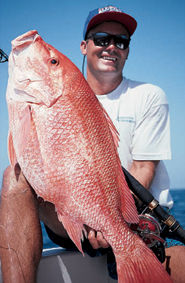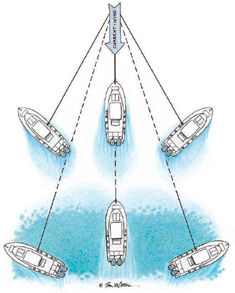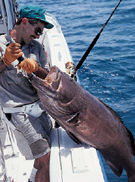
Catching bottom fish around structure is often harder than it looks. Scoring consistently, especially with bigger fish, requires a lot of thought and some knowledge of precision anchoring. Just recently, Captain Dennis Forgione and I were targeting black grouper along a reef in the Bahamas. After losing a few big fish to the rugged bottom, it became obvious that we had to modify our tactics.
So we pulled anchor and idled around until we found a large, sandy patch between sections of the reef. We then re-anchored so that the boat would sit directly over the sand. With the closest piece of reef now 50 feet behind us, we resumed chumming to rally the yellowtail snapper and baitfish. Our plan was simple: Let the chum draw in schools of yellowtail and other fish, creating a frenzy of activity that would ultimately attract large grouper from their lairs and onto the sand. If we hooked up, we'd have a fighting chance of turning the fish with our 30- and 50-pound stand-up tackle before it could power back to the reef.
The tactic worked like a charm, and we succeeded in catching grouper up to 32 pounds that day. One week later, at that very same spot, Dennis bagged a 52-pounder, along with four mutton snapper between ten and 12 pounds!
Precision anchoring requires an understanding of how the wind and current will influence your position. As in the above example, it's sometimes necessary to factor in the distance from the piece of structure you plan on fishing, as this extra room could help you land a big fish.
Many bottom fishermen, myself included, often drop their baits right next to the structure we know holds big fish. And under the right circumstances we succeed in catching them. Yet sometimes we can't stop a big grouper, snapper or amberjack from charging back to the reef or wreck and cutting us off. If large bottom fish are lurking around your wrecks, rigs and reefs, or smaller species that could pose a similar threat on light tackle, it's to your advantage to put a little more water between the boat and the structure.
 It's possible to work different parts of a wreck, reef or rockpile without re-anchoring by simply letting out more anchor line or tying off to a midships cleat to swing the boat to the side. |
'Getting situated on a wreck or other high-profile structure is generally a happy medium of being not too far from it and not too close to it,'� says Forgione. 'When I'm fishing the wrecks off Miami, I account for the wind and current before anchoring. I want the wreck to lie directly behind me. The velocity of the current also becomes an issue. On the deeper wrecks in 150 to 240 feet of water, I'll judge the speed of the current and whether my chum '’’ which are chunks of bait '’’ will make it down to the wreck. If it appears the chunks are drifting over the wreck, I'll anchor farther upcurrent to make certain they filter down to its upcurrent side. Sometimes I'll anchor as far as 200 yards ahead of a deep-water wreck. Distance is quite important for chumming if you want the technique to work.'�
As mentioned, precision anchoring requires a good understanding of how the wind and current will affect your setup. When bottom fishing, the basic objective is to position the boat so that you can effectively bait and catch fish from a piece of structure. Miss the mark by several feet and it may feel like you're fishing in a desert.
I recall a grouper trip off Florida's west coast where we anchored along a shelf in 60 feet of water. The initial anchoring put us slightly upcurrent and some 30 yards to the left of our intended target, but since the shelf extended behind our boat we figured that we'd still catch fish. Wrong! Both dead and live baits couldn't muster a strike. To get into the gag grouper, we had to reposition the boat to where we were right in front of that particular shelf.
Learning how to compensate for wind and current when attempting to anchor on your target can be as easy as tossing over a marker buoy or float once the prime structure appears on your fishfinder. With such a visual aid, it will be much easier to keep track of the structure and see exactly how your boat will lay in relation to it as you anchor. You'll also be able to determine what adjustments you'll need to fine-tune the job. The more experience you gain at anchoring over structure, the more efficient you'll become at it. Also, don't get lazy. If you're not 100-percent satisfied with your initial anchoring job, do it again! Some of the best anglers in the business reposition their boats several times or more until they're exactly where they need to be. It's this extra effort that puts them into fish.
 When wind is opposing current in a conventional anchoring situation, fishing lines will be swept toward the bow. The problem can be solved by tying off to a midships cleat, which allows anglers to fish their lines straight back off the side of the boat '’’ a much better position for detecting strikes and fighting fish. |
Catching bottom fish also boils down to locating their whereabouts along and around a piece of structure, such as a wreck, rig, ledge or reef. In some cases, the fish may be holding upcurrent of the structure or along a very specific part of the structure. In other cases the action may be occurring downcurrent. Pockets of activity are usually revealed on the fishfinder prior to anchoring, giving the angler an idea of where he needs to be fishing. However, these hot spots can shift based on a shift in current or food concentration. If you've been catching fish and the bite eventually slows or shuts down, it may be necessary to probe other sections of the structure.
Off-Center Anchoring
Providing there's ample current, off-center anchoring is a tactic that enables an angler to fish different parts of a wreck, ledge or reef without having to reset the anchor. By uncleating the anchor line from the bow cleat and either cleating it off to a midships cleat or bringing it down around a bow rail stanchion and back to the bow cleat, you can adjust how the vessel lies in relation to the structure.
For example, if you're anchored directly upcurrent of a wreck and secure the anchor line to the starboard midships cleat or the starboard bow-rail stanchion, the vessel will swing toward the right side of the wreck (if you're in the cockpit facing aft toward the wreck). If the line is cleated off the port side, the vessel will swing toward the left side of the wreck. The exact distance of the swing will vary based on the depth of the water you're anchored in, the amount of anchor line out, and the length of the boat. Also, the farther aft the line is cleated off, the farther to the side the boat will swing. With some experimenting, you'll often be able to cover more ground than you did on the initial set '’’ without having to re-anchor. And should you want to investigate the downcurrent side of the structure, simply let out more anchor line. You can also try the same midships adjustments on the backside.
 The ability to anchor in exactly the right spot paid off with this massive black grouper taken in the Bahamas. |
It should be noted that off-center anchoring is recommended only in calm seas, since your vessel will be laying more broadside to them. Watch out for large wakes as well. In a threatening situation, always secure the anchor line to the center bow cleat.
One challenge that often makes anchored fishing difficult occurs when the wind opposes and overpowers a current. For example, if the anchor line is cleated to the bow cleat and the stern is lying downwind, the current could sweep the fishing lines toward the bow. By tying off the anchor line to a midships cleat, the boat should lie perpendicular to the current, allowing for an efficient fishing spread on the downcurrent side of the boat '’’ most of the time. It's not the most desirable setup, but at least you can fish somewhat efficiently.
Locating good structure is one thing, but knowing how to anchor on it is what really puts you into fish. Bottom fishing is often a game of inches. If you're good at precision anchoring and making the necessary adjustments, you stand to score big. However, if you approach the game with a lackadaisical attitude and settle for just any drop of the hook, you're probably better off wetting a line back at the dock!

